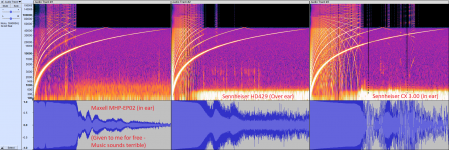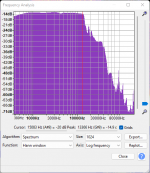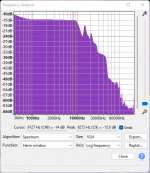So i received a free set of headphones with a parcel today. On the back I noticed its frequency response spec on the back (20-10kHz) So I thought i'd try to see if i could test and confirm those specs, which i could. Though I was a little bit surprised with what I found.
Maxell MHP-EP02 (in ear) (10kHz spec, 13 to 10kHz measured)
Sennheiser HD429 (over ear) (22kHz spec, 9kHz measured)
Sennheiser CX 3.00 (in ear) (21kHz spec, 16kHz measured)
Thoughts?
- First, it turned out that I had the wrong settings on my computer which limited the output to 23kHz, so that was rectified.
- It turns out that even if its frequency response was only up to 10kHz, I could still measure output up to 40kHz.
- Understanding that the 10kHz earphone spec is where output volume begins to drops, not where it fades to zero. (Measured as 13.3kHz first try and dropped to 10kHz on subsequent tests)
- After testing the over ear sennheisers a few more times, it seems i'm getting drop outs. I wonder if doing these tests is damaging my DAC, headphones and/or mic....
- So it may still be possible that I haven't lost my precious young high frequency hearing just yet, and perhaps maybe it's just the limit of my old headphones or is the limit of my old DAC?
Maxell MHP-EP02 (in ear) (10kHz spec, 13 to 10kHz measured)
Sennheiser HD429 (over ear) (22kHz spec, 9kHz measured)
Sennheiser CX 3.00 (in ear) (21kHz spec, 16kHz measured)
Thoughts?
Attachments
-
 3x headphones test.png423.6 KB · Views: 52
3x headphones test.png423.6 KB · Views: 52 -
 3x headphones retest 2.png533.5 KB · Views: 50
3x headphones retest 2.png533.5 KB · Views: 50 -
 Maxell MHP-EP02 (in ear) Freqency Response 13kHz.png10.4 KB · Views: 55
Maxell MHP-EP02 (in ear) Freqency Response 13kHz.png10.4 KB · Views: 55 -
 Sennheiser CX 3.00 (in ear) Freqency Response 16kHz.png10.1 KB · Views: 61
Sennheiser CX 3.00 (in ear) Freqency Response 16kHz.png10.1 KB · Views: 61 -
 Sennheiser HD429 (Over ear) Freqency Response 9kHz.png10.4 KB · Views: 53
Sennheiser HD429 (Over ear) Freqency Response 9kHz.png10.4 KB · Views: 53
The sample rate has nothing to do with the number of instruments that can be registered. It has to do with the highest frequency that can be recorded. Terrible anaology.
Yes & no....
Everybody keeps going back to the Nyquist–Shannon sampling theorem....which was originally discovered back in 1915 by E.T. Whittaker...& well before digital recordings etc were invented..so just a "paper theorem" & no actual in reality measurements..& it really only applies to certain mathematical functions..strictly speaking...
https://en.wikipedia.org/wiki/Nyquist–Shannon_sampling_theorem
As I stated before some people in lab conditions can register 28kHz..therfore twice that is 56kHz.....which is higher than the twice the normal human hearing range of 20kHz...that the 44.1kHz is used
Analogue studio masters in good condition will yield 96kHz.....so the music is sampled twice in the previous 44.1kHz time frame...the reason is for much better mastering....
However this article from a company which makes digitisers is good read..& I've highlighted the important section:-
https://spectrum-instrumentation.co.../hardware_features/Sampling_Speed_Details.php
QUOTE:-
The sampling theorem states that to avoid aliasing, the sample rate of a digitizer needs to be at least twice the highest frequency component in the signal being acquired. Sampling at just twice the highest frequency component is not enough to accurately reproduce fast edges in time-domain signals. Accurate digitizing of a signal requires the digitizer's sample rate should be at least five to ten times the required bandwidth. The below screenshots show the same sine signal being sampled with different sampling rates both in time domain and frequency domain:
END QUOTE
Basically its "oversampling".....which improves resolution & decreases noise...
https://en.wikipedia.org/wiki/Oversampling
I can hear the difference & so can others (not hi-fi geeks) who I have done blind testing with using the same setup & same songs...96kHz & etc is worth it if the studio masters can provide it
Would that be Bruce Wayne by any chance? Jokes aside, I find it pretty hard to believe. Is it perhaps a toddler or a small child maybe?As I stated before some people in lab conditions can register 28kHz.
Well, with my current set up, I can't hear beyond 16kHz. That could be my ears or my hardware, I'm not yet sure.I can hear the difference & so can others (not hi-fi geeks) who I have done blind testing with using the same setup & same songs...96kHz & etc is worth it if the studio masters can provide it
TonyEE never posted his recordings, so I'll never know... Unless someone else can upload a hi res recording for me please?
As a side project after sorting out my headphone delema, I plan to do those back to back blind tests to see if I can tell the difference...
But judging from this girls results, I don't like my chances...
I read someone opinion somewhere: "If he can not hear the difference, so everyone must be can not either." or "If average people can not hear the different, why bother who can hear it?" Something like that.I can hear the difference & so can others (not hi-fi geeks) who I have done blind testing with using the same setup & same songs...96kHz & etc is worth it if the studio masters can provide it
Bimo, or better yet, if my own ears are physically incapable of hearing the difference, then i shouldn't bother wasting my time either. And from what i understand, my hearing is only going to get worse as i age... So spending thousands on high end turntables etc would be a bad investment.
Yes. Period. Nothing you have said here supports your assertion that sampling rate correlates with the number of instruments that can be perceived.Yes & no....
I even have trouble telling apart atrac type R on my mini disc recorded digitally from CD rips. Perhaps some compression artifacts are only just barely perceivable if i focus with eyes closed and no distractions. But to my ears and with my hardware, even atrac easily sounds better than vinyl... Well, until proven and experience otherwise.Absolutely. MP3 is more than satisfactory for majority.
I'm really starting to understand that vinyl really is a mediocre format at best. Definitely not the gold standard some people make it out to be.
I suspect those who try to convince others into spending thousands on analogue gear; are really just trying to justify their regretful purchase to themselves...
Maybe for you. 😉I'm really starting to understand that vinyl really is a mediocre format at best.
jeff
That's old news now. There's a huge thread over on the Hoffman forum that's been raging for 3 weeks.Interesting story about Mobile Fidelity and analog vs digital in the Washington Post today.
jeff
For me, vinyl has been superseded by high-rate DSD, which I especially love when paired with a Single-Ended Tube Amp (I have a Tubelabs design).
I do have a fairly good and affordable vinyl setup though and most of my collection is made up of discounted vinyls.
Best thing you can do with vinyl is capture it at high-rate DSD and archive it. Every single playback degrades them. Not so with digital.
I do have a fairly good and affordable vinyl setup though and most of my collection is made up of discounted vinyls.
Best thing you can do with vinyl is capture it at high-rate DSD and archive it. Every single playback degrades them. Not so with digital.
Feel free to provide evidence to prove otherwise. Litterally no one in #133 posts has bothered to provide recordings. Yet i've posted hi res wavs from the first post and captured frequency response diagrams of the hardware i have used. Yet the best vinylphiles can do is provide anecdotal stories. I'm sorry but in science, ear witness testimony is the absolute lowest form of evidence. I am willing to bet that the perceived superior vinyl hi-fi is all merely placebo effect.Maybe for you. 😉
jeff
I didn't find this to be true. Some LP's I bought in 1970. But the US Army destroyed my hearing above 14 khz in 1969. It is still there, perhaps due to aggressive earplug use in noisy situations.Every single playback degrades them. Not so with digital.
Track at 1.5 g or less, inspect the diamond that the edges are round occasionally, clean the dirt off occasionally, put the record away to keep the dirt off. I use running tap water with Palmolive detergeant dilute followed by DI rinse.
I don't have the time or the energy right now. Maybe when I retire.Feel free to provide evidence to prove otherwise. Litterally no one in #133 posts has bothered to provide recordings.
I would never way that vinyl was the superior format anyway. But when done right, it can be very good.
jeff
Last edited:
Would that be Bruce Wayne by any chance? Jokes aside, I find it pretty hard to believe. Is it perhaps a toddler or a small child maybe?
Well, with my current set up, I can't hear beyond 16kHz. That could be my ears or my hardware, I'm not yet sure.
TonyEE never posted his recordings, so I'll never know... Unless someone else can upload a hi res recording for me please?
As a side project after sorting out my headphone delema, I plan to do those back to back blind tests to see if I can tell the difference...
But judging from this girls results, I don't like my chances...
I don't know I didn't read the whole report as it was an aside in another medical report.....
I know my hearing can register the limits in terms of low dB, let alone high frequency of a full UK NHS test done properly in a sound proof room in the specialist dept at the hospital..& that was done in the past few years...& I've got at least 10 years on you in terms of age...
I'm not uploading my purchased Hi-res stuff from Naim or Linn or any of my other stuff...I don't think they would like it from a legal perspective.....plenty of places you can purchase it from on the web like I did though!
The human senses differ in terms resolution, range, quality, sensitivity etc from one person to the next.....therefore I don't expect you, now, with your "duff" hearing (as you admit) to be able to appreciate what I can hear.
@humbug
The long story made as short as possible, in my opinion, is;
1) Vinyl is different than digital, and not necessarily better. However, when it is good, it absolutely lives up to the hype.
2) As mentioned by others, in Vinyl absolutely everything counts, the cost floor of good reproduction isn't cheap, and it is the one place in the audio chain where throwing money at it usually gets real improvements.
3) Very good reproduction is breathtakingly simpler and more inexpensive in the digital realm than Vinyl. Period.
4) In terms of objective measurements, particularly compared to a digital format, Vinyl will never measure well.
So what is the hype? When a good Vinyl system is running on all cylinders, it has an ineffable subjective quality that is very attractive and wonderful. That‘s why people go though the bother and effort. 😎
The long story made as short as possible, in my opinion, is;
1) Vinyl is different than digital, and not necessarily better. However, when it is good, it absolutely lives up to the hype.
2) As mentioned by others, in Vinyl absolutely everything counts, the cost floor of good reproduction isn't cheap, and it is the one place in the audio chain where throwing money at it usually gets real improvements.
3) Very good reproduction is breathtakingly simpler and more inexpensive in the digital realm than Vinyl. Period.
4) In terms of objective measurements, particularly compared to a digital format, Vinyl will never measure well.
So what is the hype? When a good Vinyl system is running on all cylinders, it has an ineffable subjective quality that is very attractive and wonderful. That‘s why people go though the bother and effort. 😎
It's amazing that some people (some on here remaining nameless) nitpick over such trivial things regarding the playing and perfection levels of LP records.I don't have the time or the energy right now. Maybe when I retire.
I would never way that vinyl was the superior format anyway. But when done right, it can be very good.
jeff
Simple care when using/storing/turntable maintaining results in satisfying performance.
Except, of course, if a person nitpicks and insists on being unreasonably critical over the mechanical retrieval of music from a mass-produced flat vinyl disk.
Vinyl is not for everybody. But there are perfectly justified resons why some folks use it.
When i finally got my first CD player in the late 80's I realized with anguish it can't produce the same sense of 'musician in the room' that my half decent turntable often used to do. Inspite the limited freq range, obvious distortion and clicks, for some unknown psychoacoustical reason the illusion created by vinyl was much stronger then by CD.
Only after decades I obtained serious enough DAC that is doubtlessly better in that aspect.
Most people don't need hi-fi and are quite happy with mass produced entertainment electronics. Those practical individuals should not waste their time on forums like this because they don't get it.
When i finally got my first CD player in the late 80's I realized with anguish it can't produce the same sense of 'musician in the room' that my half decent turntable often used to do. Inspite the limited freq range, obvious distortion and clicks, for some unknown psychoacoustical reason the illusion created by vinyl was much stronger then by CD.
Only after decades I obtained serious enough DAC that is doubtlessly better in that aspect.
Most people don't need hi-fi and are quite happy with mass produced entertainment electronics. Those practical individuals should not waste their time on forums like this because they don't get it.
Last edited:
Would it be better to have the turntable on the concrete floor, or should I put a thick foam mat under it? I assume this is to
I could easily buy cork or felt. I'm assuming cork would be grippier and not likely to leave fluff stuck to the record. I'd need to make sure the height isn't affected thus changing the horizontal angle of the tone arm. But what effect does each material have on audio?
I'll probably skip that one.
I don't know anyone local who I could borrow anything from.
I've not fiddled with tonearm alignment (I don't think its adjustable). The cartridge was aligned by eye using those printed templates. But I don't think its that critical as the tone arm doesn't stay tangent to the track grooves anyway. I don't see how it could influence tonal balance that much as I would hear it change while playing from start/middle/end.
On a side note, I'm not too surprised TonyEE did a runner. I get the feeling that high end audiophile stuff is more like audiophool snake oil
"runner"?
I got tons of files, but I need to figure out how to send you that file. I don't use public storage for privacy reasons. If I post it on my own web site, you will have to make sure to keep it very private.
In the meantime, I've been pretty busy, believe it or not.
And even a small file is "too large" to upload into this forum.... just a single song, for the rare recordings that I broke up into songs, turns out to be at least 100MB. I keep everything in 25/96 WAV files. Using Cubase I did play around with removing ticks, normalizing and even converting to Red Book. So those recordings I'm looking at to send you are about 12 years old, with the Grado Sonata, not the Master... and I've also done very significant upgrades to the turntable and preamp. Mostly the noise level has dropped, the new cartridge plays different parts of the groove so there's less "scratches" and the sound is amazing ( OK, upgraded the amps and speakers too...).
Recording analog is a lot of work, trust me, and even as I spent more and more money on the AD/DAC set up, I also spent more and more money on the turntable, cartridge and preamp, which meant that I had to keep re-recording. So, I sort of stopped recording LPs on a regular basis. I just keep them clean and play them.
The reason for up'ing to the RME is to record the downloaded Tidal HiFi audio which gets stored in some kind of closed sourced hashed format.
BTW, don't insult... it's not audiophool stuff, you can hear it.
Last edited:
- Home
- Source & Line
- Analogue Source
- Vinyl not as perfect as I was expecting? First time Recording to Hi-Res Digital